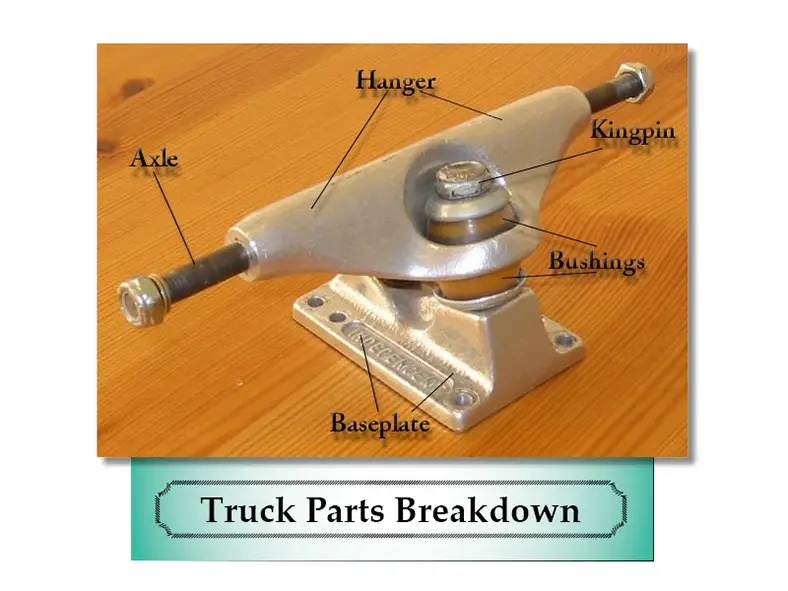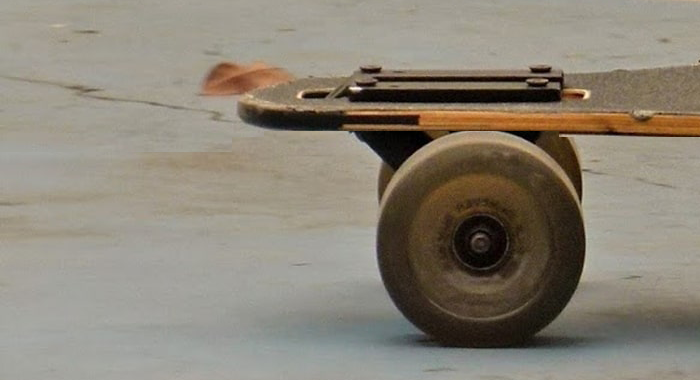There are several things in this world that can bring an immediate stop to an otherwise fun longboarding session: rain, security guards, rocks, and wheel bite. There isn’t a whole lot you can do to stop these anti-skate forces, but the last one, wheel bite, is worth understanding on a deeper level.
So what is wheel bite?
If you’ve skated any deck for a while, be it a street deck, longboard, cruiser deck, or skateboard, you’ll notice little areas where the paint has rubbed away above the wheels. The culprit? Wheel bite.
Turning sharply on your board and also the impact of your own body weight coming down atop the board will cause the deck to rub against the wheels. Wheel bite occurs more frequently and more easily if you ride with loose trucks, where the nut on top of the kingpin isn’t kept very tight.
Is wheel bite normal on a longboard?
But, even if you ride with tight trucks, some contact is still inevitable. It’s a bit like raindrops or rocks in the pavement — you simply can’t avoid them at all times. And like little rocks in the pavement, wheel bite can bring your board and you to a sudden stop.
As long as your wheels are close enough to touch your deck while turning, there will be the possibility of wheel bite. It’s not anyone’s favorite part of longboarding, but, unfortunately, it’s hard to avoid.
How to prevent wheel bite
1. Tighten your trucks
We say that wheel bite is somewhat unavoidable because there are steps that you can take to reduce it. You could tighten your trucks, but many skaters prefer to ride with loose trucks as it increases turnability, makes your board more maneuverable, and just makes your board more rideable, some argue.
To tighten your trucks, all you need is a $12 skateboard tool.
2. Add riser pads
Some skaters add riser pads between the trucks’ baseplate and the deck to increase the distance between wheels and the deck and absorb impact. This is one solution. These little inserts might even increase your pop when ollieing, but they might also affect how your board feels and maneuvers. They’re worth a try if wheel bite is a constant issue.
3. Use the right-sized wheels
On the topic of trucks, make sure that your longboard wheels aren’t too big for your trucks. If you have large longboard wheels but short trucks, there won’t be very much clearance between your wheels and your longboard deck. Low-profile trucks typically stand 46–49 mm in height from the baseplate to the top of the hanger.
So, if you’re riding lower trucks, make sure your wheels don’t exceed 50–53 mm in diameter. If you’re riding mid or higher-profile trucks, wheel size won’t be as much of an issue in terms of preventing wheel bite.
4. Change your bushings
Instead of tightening your trucks, you might also swap your bushings, which are the little urethane rings that go around the kingpin. Bushings come in various durometer measurements, which indicates their hardness. Harder, larger bushings will be stiffer, so your wheels will be less likely to come in contact with your deck. However, changing your bushings will affect your board feels — actually, any modification to your trucks can affect how your board feels.
Sometimes it’s just a matter of getting used to a different feel and rideability. After all, if you’re having frequent wheel bite issues, it’s better to have to get used to a new board setup than to be constantly screeched to a halt by wheel bite!
Built-in bite prevention
For longboards and some cruiser boards, there’s more variation as far as the trucks design and features. While it’s typically best for street skateboards to be the same width as the length of your trucks, meaning the edge of your wheels lines up with the edge of your deck, for longboards, this isn’t always the case.
Some longboarding trucks extend beyond the edge of your deck, which can improve stability. If wheels extend way out beyond the deck, wheel bite can’t occur.
Still, other longboard decks contain wheel wells. These little rounded pockets conform to the shape of the wheel, decreasing the surface area that can brush up against wheels and also conforming to the wheels’ shape, should it occur.
With a lot of longboards and decks that contain wheel wells, they’re often made to ride with loose trucks, so that you can have great maneuverability and a mellow ride, as these boards intend.
Will wheel bite damage my longboard?
Over time, wheel bite can lead to some minor damage to your board. Your wheels will become rougher and dirtier than they were in the beginning, and rubbing up against your board will lead to scrapes on the bottom and side of your board.
This isn’t necessarily a bad thing, though. The only longboards that are in perfect condition are the ones that don’t get used. Beat your board up a little bit! That’s part of the fun!
Sick of dealing with wheel bite?
Even if you change your setup to prevent wheel bite, it might still occur. That’s just part of longboarding! Similarly, how your board feels all around—meaning its maneuverability, handling, pop, and other factors—will probably be of greater importance than solely its ability to prevent wheel bite. Stopping wheel bite is important, sure, but, frankly, so are many other variables.
A little wheel bite here and there will probably make you fall off your board or frustratingly come to a sudden stop when atop your board. But, guess what? There are a whole host of other obstacles and objects that will also make you fall off your board and come to a stop. Stay ahead of all that by wearing proper safety gear including knee and elbow pads, wrist guards, and one of the best longboarding helmets.
Preventing it can only improve your ability to ride your board and have a great time doing so. Yet it’s still just one consideration, among many, when setting up and enjoying your board.









